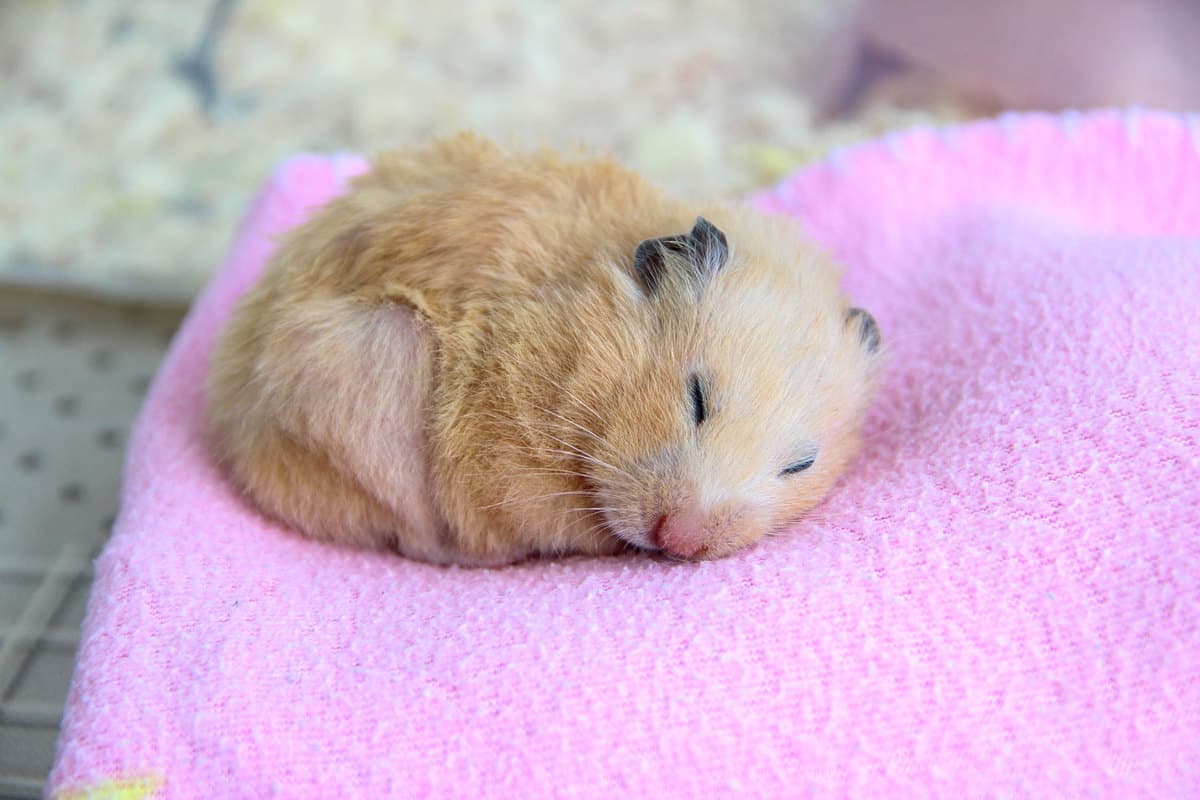Do you want to know if hamsters are active at night? Having a hamster for the first time can raise this concern.
Hamsters, after all, are prone to sleeping throughout the day and acting up when the clock strikes midnight.
So, hamsters are nocturnal creatures, right? The fact that hamsters are not nocturnal may surprise you, given their behavior.
They are, in fact, crepuscular animals, which means they are most active in the early evening and early morning hours (dusk and dawn).
You may be wondering, at this point, why hamsters are considered nocturnal animals.
Can you tell me what I can or cannot do as a pet owner to meet my pet’s natural tendencies?
You may find out the answers to these questions and more about your favorite furballs if you continue reading.
Why Are Hamsters Crepuscular and Not Nocturnal?
Several factors influence whether an animal is diurnal, nocturnal, or crepuscular in its activity.
Among the most significant things that influence an animal’s sleeping habits are:
- the environment
- the status as predator or prey
Hamsters Live in Hot Climates
The sleeping patterns of most animals are influenced by their surroundings.
In order to conserve energy, animals in hot areas often sleep during the daytime. They’ll be more active at night and search for food at twilight.
A majority of animals in colder climes are nocturnal and only awake when it gets dark.
European, Middle Eastern, and Asian countries are home to wild hamsters. They tend to like hot, dry environments.
Hamsters spend the day in underground tunnel systems known as burrows. Compared to the outside, these tunnels are much cooler.
When it’s too hot outside, the hamsters will spend the day in their burrows, where they will sleep and eat.
Hamsters awaken around dusk and go on the hunt for food in the outer world. At this point, the majority of hamsters are quite active.
Hamsters dislike temperatures that are either too high or too low. They can even go into “hibernation” when the temperature drops too low for their liking.
Normal room temperatures are the most comfortable for hamsters. At dawn and sunset in the desert, this kind of temperature is common. The hamster doesn’t get too hot or too cold at these times.
Hamsters Are Prey Animals
The sleeping patterns of predators and prey are adapted to each other. When prey is accessible, predators will be active.
Prey, on the other hand, will strive to stay out of the way of their main predators when they are out hunting.
As you may have suspected, hamsters are prey animals rather than predators. The hamster is prey to birds, canids, snakes, and wild cats, to name a few.
When their predators are awake, hamsters will naturally try to stay indoors when it’s dark outdoors.
Because their primary predators are nocturnal, it’s only logical that they awoke at the same time their prey was sleeping.
If hamsters were nocturnal like their predators, they’d be up and on the hunt for food at the same time. For the sake of the hamster, this is a terrible decision.
What Are the Consequences of Being Crepuscular?
The fact that hamsters are nocturnal has several unintended implications. The following are serious ramifications:
- hamsters will sleep most of the day with perhaps short periods of activity
- they don’t like to be interrupted during the day
- they will become really active at dawn and dusk
This shouldn’t be a problem for the majority of individuals. If you’re at work or school throughout the day, your hamster will be safe and sound in its cage.
Your hamster will just wake up when you go home at night. When it comes to feeding and playing with your pet, it’s likely that you’ll still be able to do both.
However, hamsters’ nocturnal habits have certain potential drawbacks:
- not that suitable for young children that are already in bed when the hamster wakes up
- the cage should be placed in a location that experiences a normal day/night light cycle
- if you don’t want to be wakened up during the night, don’t place the cage in a bedroom
- you don’t want to make a lot of noise in the vicinity of the cage during the day
Do Hamsters Need a Light on at Night?
Unlike humans, hamsters’ nighttime activity does not necessitate the use of a light source. In fact, they like it that way since they flourish in the shadows.
Because of their poor eyesight, a light wouldn’t do any benefit for hamsters.
Your hamster, on the other hand, will simply become agitated by the light since the darkness tells them it’s time to party.
As a result, you should turn off the lights and allow them to cruise along on their own in the dark.
Where Does Your Hamster Sleep?
A tunnel under the ground is where your hamster naturally sleeps. In a hamster cage, it will be impossible to replicate the tunneling network.
You can, however, give a hamster a safe place to sleep by giving it a house. Plastic or unfurnished wood can be used to build this house.
Despite the fact that plastic hamster houses are readily available, it’s advisable to buy or build a wooden one. It’s safe for your pet hamster to gnaw on his home if he feels like it.
Place the hamster house in the darkest corner of the hamster’s cage if possible. It is not unusual for hamsters to spend the entire day in this cozy abode.
Wait, there’s more! When I visit a pet store, I often notice hamsters snoozing in open cages. How did that happen?
Indeed, this may have escaped your attention, and there is a slew of variables at play.
Some hamster species, like dwarf hamsters, enjoy snuggling up together, but this is not always practical in a hamster’s home. They assemble into a mound.
Can You Train a Hamster to Sleep at Night?

At night, running on their wheels can be a bother if you have a hamster in your bedroom. With this in mind, you’ve probably wondered if it is possible to train a hamster to sleep at night.
The good news is that you can easily alter your hamster’s sleeping habits. It will, however, take a significant amount of effort and perseverance.
As a result of this four-step instruction, you’ll learn how to better control your hamster’s sleeping habits:
Step 1: Build a Good Relationship
A trustworthy relationship between you and your hamster is the first step in the process. You can cultivate this bond by feeding them often and playing with them daily.
Eventually, your hamster will become comfortable around you.
Once this happens, the hamster will start to anticipate your company and enjoy spending time with you.
And after this bond is formed, it will make the following steps a lot less difficult and stressful for both of you.
Step 2: Remove the Light During the Day
You can fool your hamster into believing it is twilight or dawn even though it is daytime.
Using curtains or a blanket to cover the cage is one option, but there are others as well.
Be sure to keep it ventilated.
Step 3: Keep the Schedule Consistent
It’s not a good idea to try to change your hamster’s sleeping habits too much. As a result, it’s critical that you adhere strictly to a predetermined strategy.
Keep your hamster in the dark at the same time each day.
By doing so, you gradually rewire their brains to believe that day has just given way to night.
The problem is that if you don’t follow a regular regimen, you could lose all of the gains you’ve achieved.
Step 4: Remain Patient
A week or two won’t be enough time to finish this process.
Changing your hamster’s habits will likely take months, so be sure to stick to the three phases outlined above and gradually introduce your new routine to your pet.
Feeding the hamsters or removing them from their cage may help speed up the process. Both of these things will help you and your hamster develop a stronger bond.
How to gently wake up your hamster
If you need your hamster to be awake right now for any reason, you can use this method.
Take a small bit of something he enjoys, such as a treat or favorite food. In order to lure him out, softly tap on the side of his cage and chat with him.
Bedding will rustle as he wakes up and turns towards you in his house.
As he sniffs the air, you’ll get a glimpse of his face. When this happens, it’s better to keep the treat nearby so he can find it.
After that, you’ll see him gently emerge, his ears tucked back and his eyes drowsy as can be. Once he gets close enough, you can pick him up and give him the treat.
When they first wake up, hamsters resemble us in many ways. Gloomy, and a tad unsure about one’s surroundings.
As a result, handling your hamster for a short period of time will result in increased comfort for both of you.
If you use this strategy too much, your hamster will become frustrated and you will not be able to bring him back to sleep.
In the long run, you’ll have an agitated, angry hamster chewing its cage and even you.
Final Words
The fact that hamsters operate on a different timetable than humans can make things a little perplexing for a while.
But don’t worry, you’ll become used to it in a matter of weeks.
When you inform your neighbors and friends that you’re awake at night and asleep during the day, their reaction is priceless.






